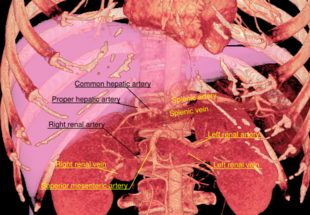Medicine:Distal splenorenal shunt procedure
In medicine, a distal splenorenal shunt procedure (DSRS), also splenorenal shunt procedure and Warren shunt,[1] is a surgical procedure in which the distal splenic vein (a part of the portal venous system) is attached to the left renal vein (a part of the systemic venous system). It is used to treat portal hypertension and its main complication (esophageal varices).[2] It was developed by W. Dean Warren.
Splenopancreatic and gastric disconnection (SPGD)
DSRS is typically done with splenopancreatic and gastric disconnection (ligation of the gastric veins and pancreatic veins (that drain into the portal vein) and complete detachment of the splenic vein from the portal venous system), as it improves the outcome.[3]
Comparison to TIPS
Survival with a transjugular intrahepatic portosystemic shunt (TIPS) versus a DSRS is thought to be approximately similar,[4][5] but still an area of intensive research.[6][7]
Both TIPS and DSRS lead to decreased rates of variceal bleeding at the expense of hepatic encephalopathy; however, TIPS appears to have more shunt dysfunction and lead to more encephalopathy and bleeds.[5] DSRS appears to be more cost effective than TIPS.[8]
References
- ↑ "Distal splenorenal shunt versus endoscopic sclerotherapy for long-term management of variceal bleeding. Preliminary report of a prospective, randomized trial". Ann. Surg. 203 (5): 454–62. May 1986. doi:10.1097/00000658-198605000-00002. PMID 3486641.
- ↑ "Effect of distal splenorenal shunt on survival of patients with primary biliary cirrhosis". Hepatology 20 (6): 1482–6. December 1994. doi:10.1002/hep.1840200617. PMID 7982648.
- ↑ "Appraisal of DSRS with SPGD for esophagogastric varices: a retrospective comparative study according to the underlying liver diseases". Hepatogastroenterology 52 (61): 152–5. 2005. PMID 15783017.
- ↑ Rockey, DC. "Update on the Role of TIPS in the Management of Portal Hypertension". WebMD LLC. http://www.medscape.com/viewarticle/492983.
- ↑ Jump up to: 5.0 5.1 "Portosystemic shunts versus endoscopic therapy for variceal rebleeding in patients with cirrhosis". Cochrane Database Syst Rev (4): CD000553. October 2006. doi:10.1002/14651858.CD000553.pub2. PMID 17054131.
- ↑ "Multicenter, Randomized Trial of DSRS vs. TIPS". University of Wisconsin- Madison, General Surgery. http://www.surgery.wisc.edu/general/research/grants_rikkers_nih.shtml.
- ↑ "Distal splenorenal shunt versus transjugular intrahepatic portal systematic shunt for variceal bleeding: a randomized trial". Gastroenterology 130 (6): 1643–51. May 2006. doi:10.1053/j.gastro.2006.02.008. PMID 16697728.
- ↑ "Decision-analysis of transjugular intrahepatic portosystemic shunt versus distal splenorenal shunt for portal hypertension". Hepatology 29 (5): 1399–405. May 1999. doi:10.1002/hep.510290512. PMID 10216122.
External links
- Distal Splenorenal Shunt Procedure (Cleveland Clinic) - has some schematics that show what is done in the procedure.
- Portal Hypertension (Mohawk Valley Vascular Center) - has some schematics that show what is done in the procedure.
 |


